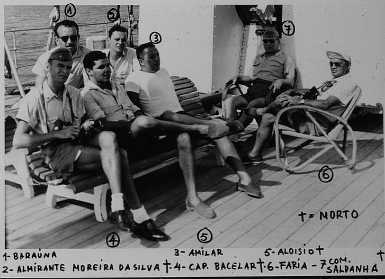
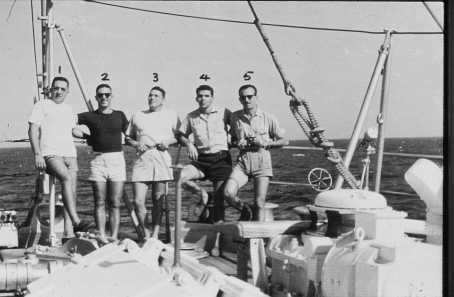
TYPE: CE I
DATE: January 16, 1958
TIME: 12:20 PM
DURATION: 1 - 2 minutes
WITNESSES: 48
PLACE: Trindade Island, off the coast of Brazil
1. Introduction
It is curious how some cases occurring many years ago have apparently been immune to the attacks of the self appointed debunkers, remaining to this day unexplained. But it is more curious when those sightings are hardly ever mentioned in the modern literature, in spite of their potential probatory value for the reality of the UFO phenomenon. Accident sometimes bring one of those sightings to the foreground, and we marvel at the reaches of information that has been simple ignored. The photographs taken in Trindale Island in 1958 are one of such cases, reactivated as a result of a personal meeting of Dr. Hynek with Almiro Barauna, the photographer, during the Second Ufological Congress in Brasilia, in April, 1983.
2. The Scenario
Trindade Island is located at 20o 30' S and 29o 20' W in the Atlantic Ocean, about 1200 Km East from the coast of Brazil, country to which it belongs. It is a rocky small place, used during World War II as an anti-submarine base by the U.S.A., and abandoned since. In October, 1958, during the International Geophysical Year, the Brazilian Navy reopened the installations, establishing a meteorological station and an oceanographic post. During January 1958, the vessel Almirante Saldanha of the Hydrographic and Navigation Division of the Brazilian Navy had arrived to the island in a routine trip, and in nthe mourning of January 16 was anchored close to the shore of the island, making ready for the return trip to Rio.


3. Cast of Characters
Beside the normal crew of the Almirante Saldanha, under the command of Jose
Saldanha da Gama, there was on board a group of submarine divers which had been
invited by the navy to take underwater photographs around the island.
The civilian group was headed by Amilcar Vieira Filho, a lawyer and bank executive,
and among others, included a retired captain of the Brazilian Air Force, Jose Teobaldo
Viegas, as well as Almiro Barauna, a professional photographer.
All in all, 48 ocular witnesses were on deck during the incident, including the ship's
dentist Lt. Homero Ribeiro. Also on board, but not on deck, was Captain (1) Carlos
Alberto Bacellar, who had been responsible for the revamping of the installation on
the island, and commander of the oceanographic station since October 1957, and was
now returning to Rio.
A few words concerning Barauna are mandatory, as the circumstances made him the leading
character of the play. At the time, Barauna was 42 years old, and had a previous
involvement with UFOs when in 1953 he refused the authenticity of the photographs
taken by Ed Keffel in a place known as Barra da Tijuna (2), publishing and article
in a popular magazine to demonstrate those photos to be fakes. This work was illustrated
with photos prepared by Barauna, who explained also how such hoaxes could be perpetrated.
It is unfortunate that Dr. Menzel, a somewhat unsuccessful debunker, as well as
others(3), used this article to cast dispersions on Barauna, presenting him as
a professional hoaxer.
(1) In the nomenclature of the Brazilian Navy, Capitán de Corbeta.
(2) Reference 3, p. 41.
(3) Reference 4.
4. The Play
On January 16, 1958, preparations to cast anchor were under way, and Barauna
was on deck with his Rolleiflex Model E camera, with a 2.8 lens. As he intented
to take photos of the boat used to go ashore during its final trip and while it
was taken on board, he has set the camera at f/8 and a speed of 1/125. The sea
was not calm, and this had upset Barauna who was forgotten to take his seasickness
pills. At 12:20 PM a disturbance occurred, when everyone on the deck become exited
by the fast approach of a bright object moving toward the island. Mr. Vieira Filho
and Mr. Viegas, as well as Lt. Ribeiro, shouted to Barauna gesticulating and
pointing to the area of the overcast sky where the object was. After about 30
seconds, Barauna proceeded to take six photographs, in time interval of 14 seconds,
as determined by tests perform later on. The first two photographs were taken while
the object was approaching the island. It then disappeared behind the central mountain
(Desejado Peak) for a few seconds, to reappear a few seconds later moving in the
opposite direction, apparently closer and bigger (photo 3). It then moved at high
speed toward the sea, but Barauna missed the object in his next two frames, due
to the confusion prevailing on the deck at the time. He managed, however, to obtain
a fourth photo when the object was already far out to the sea, when it apparently
had momentarily stopped in mid-air. After about 10 seconds, it moved and disappeared
in the distance.
Following the incident, Commander Bacellar as well as others officers insisted that
the film was developed at once, in spite of the poor facilities existing on board
and the lack of photographic paper to make prints. A bath room was transformed
into a dark room and the film was developed. The negatives were then inspected
by Bacellar and others. Frames 4 and 5 did not show the object, but only the sea
and the rocky coast.
5. The props
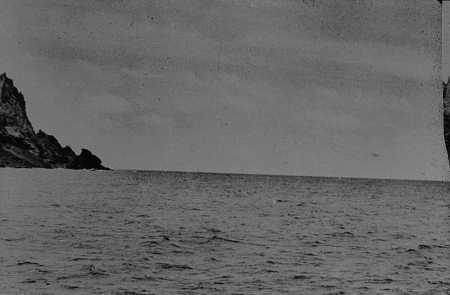
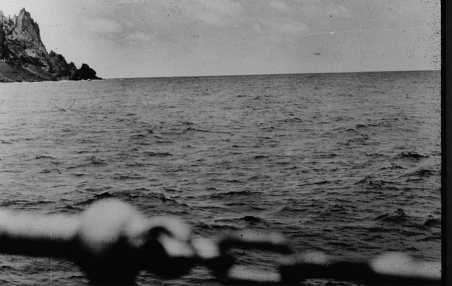
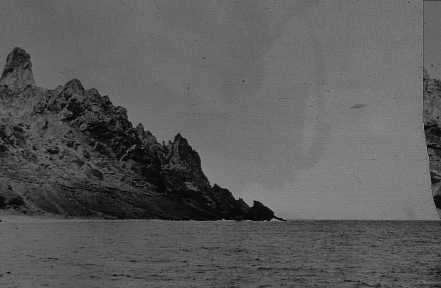
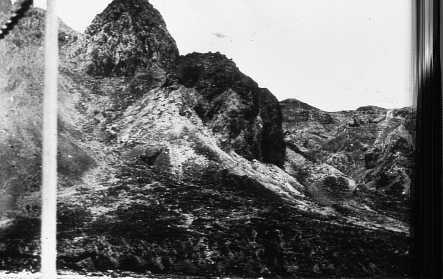
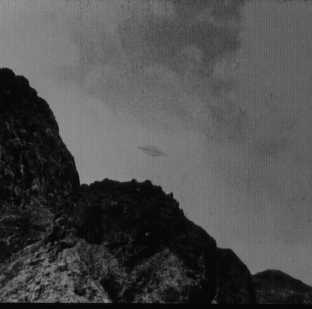
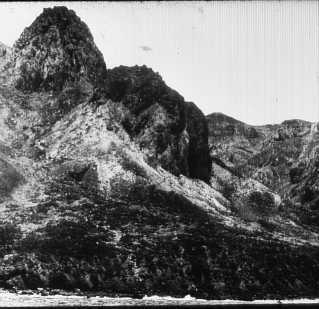
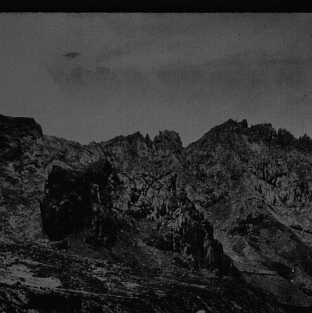
The photos was taken in a bright overcast day, and as the settings of the camera
were not quite correct, they are slightly overexposed. It was, however, a wise
decision of Barauna not to attempt to modify the setting, as if he had done so
probably would have lost his opportunity.
According to Capt. Viegas, the object was like a flattened sphere encircled at
the equator by e large ring or platform. In the words of Barauna: "it made no
noise, although with the shouting of the people on the deck and the noise of the
sea I cannot be certain. It had a metallic look, of an ash color, and had like a
condensation of e green vapor around the perimeter, particularly in the advancing
edge. Its motion was undulating, like the flight of a bat."
As determined by the photographs, the object was tilted slightly, with the upper
part directed in the direction of the motion. It appears quite sharp in photos 2
and 3, corresponding to the closest approach and minimum speed, while the contours
appear slightly burred in photos 1 and 4, corresponding to the maximum distance.
In view of the separation between object and camera, a shutter speed of 1/125 sec.
Is enough to freeze an object moving at speeds of several hundred miles per hours(1).
The object shown in the four photos resembles the planet Saturn, and it is not luminous.
The photos were proclaimed authentic by John T. Hopf, APRO photographic analyst,
as well as by the Cruzeiro do Sul Aerophotogrammetric Service, to which they were
referred by the Brazilian Navy.
(1) As per ref.2, page 168, the Brazilian Navy estimated the speed to be 600 - 700 MPH
6. The critics
The incident and the photos caused furor in Brazil and were given wide coverage by the press. An inquiry to the Ministry of the Navy made by a member of the Parliament (Sergio Magalhaes) pronted an investigation. The resulting dossier was made public in its totality but some details became known to the press, which had also discovered additional information. The incident was not isolated, but at least seven others sightings had occurred in the island or near the water during the end of 1957 and in January 1958. Some of these events were witnessed and confirmed by Commander Bacellar. A fifth photograph, taken with a box camera by a Sargent of the garrison prior to January 16, was part of the dossier, and although never released was seen by Barauna when interrogated at the Ministry of the Navy, and by Dr. Olavo Fontes. The barauna photograph were released to the press by the then President of Brazil Mr. Juscelino Kubitschek in person. The US Naval Attache in Rio (M. Sunderland, Capt. USN) filed a report on the incident on March 11, 1958, characterized by its inaccuracies and the obvious bias of the writer, epitomized by the closing paragraph:....."...a flying saucer sighting would be unlikely at the very barren island of Trindale, as everyone knows Martians are extremely loving creatures...", indeed aimed to please his superior officers. Yet, this report transcribes the official position of the Brazilian government, referring to a carefully worked communique issued by the Ministry of the Navy, denying any attempt to suppress the release of the photos that were taken by Mr. Almiro Barauna in the presence of navy officers on board of the Almirante Saldanha, and remarking that the Navy could not venture an opinion on the nature of the object that was observed over Trindale Island. The emphasis has been added to indicate that for the Brazilian Navy two things are beyond question: i) that an unidentified object had been detected over Trindale Island; and ii) that the Barauna photos were indeed taken at the location, and showed that object, whatever its nature.
Bibliography.
1. Hall, Richard. THE UFO EVIDENCE, NICAP. 1964. pp. 09-91
2. Lorenzen, Coral E., THE GREAT FLYING SAUCER HOAX, Signet Books, 1966. pp.164-74
3. Story, Ronald D., THE ENCYCLOPEDIA OF UFOS, Doubleday, 1980. pp.366-69
4. STENDEK, No.26, December 1976, p.14. Article by Michel BOUGARD, translated from an original in French.
5. Information Report, 39-58 from Office of Naval Inteligence, dated 11 March 1958, signed by M. Sunderland, Capt, USN.
